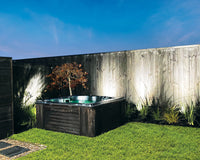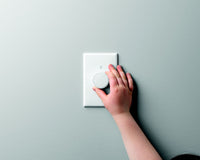What you need to know before investing in garden lighting!
While Kiwis’ travel options are still limited, many of us are continuing to invest in our homes. With shorter days now upon us, in-adequate exterior lighting becomes noticeable.
With any lighting system, the devil is in the detail. Understanding how and why each component operates will ensure you have the best possible lighting set up.
A very popular exterior lighting option is the low-voltage system. By large, low voltage lighting systems are loved for their versatility and cost-effective installation. Unlike 230volt exterior lighting, low voltage (12 & 24volt) does not require a large trench to be dug for wire cabling and “some” components can be adjusted and installed by the homeowner. Though it is crucial that anyone doing electrical work have the necessary knowledge to do so.
One component that is often glossed over within the exterior lighting “system” is the transformer. This is the component that converts mains power (230volt) into a low-level power level (generally 12 or 24 volts). We appreciate that often people tend to lead with looks before function, but arguably the transformer is the most important part of any exterior lighting system. Without a robust transformer, your lighting solution will simply not last.
There are many transformers on the market, but not all operate the same way, which can make it overwhelming to know how to pick the right solution for your needs, and importantly ensuring compatibility within your set up.
Transformer technology:
There are two main types of technology when it comes to transformers. Electronic & wire wound technology. Both have their merits, below is a brief description of the differences:
Electronic Transformers are the newer style of technology on the market. They were originally produced as an economic alternative to wire wound transformers. They are generally smaller in physical size, offer less heat dissipation and have better energy efficiency relative to their price. One watch-out to be aware of with electronic transformers, is their ability to operate under a ‘minimum’ operating capacity. This minimum operating level means that not all luminares will be compatible and specifications should be read carefully to ensure compatibility with the rest of your system components. Failure to do so could lead to performance issues.
Wire wound Transformers are often referred to as magnetic transformers. They are a simplier construction archetype compared to electronic transformers and often physically heavier due to the materials used to build them. The benefit of using Wirewound transformers is that they are often much more compatible with a wider range of luminaire types, due to their auto-resetting internal overload function and no minimum load requirement to operate. Both reduce issues with flickering and buzzing. The downside to Wirewound transformers is that they can be less energy efficient than their electronic cousins and are often harder to source, as less manufacturers now produce them.
AC or DC circuitry current:
In addition to understanding the transformer construction types there are also two circuitry currents that need to be considered before purchase, for compatibility reasons. AC = Alternating Current and DC = Direct Current. Though both types are suitable in exterior lighting situations, DC solutions are more readily available on the market due as most LED exterior Luminaires work on DC current circuitry. It always pays to check that your luminaire of choice is using the same technology as your transformer.
*Note: wire wound transfers only run-on alternative current (AC)
How to calculate your transformer needs:
The number of luminaries you wish to connect, your cable type as well as the distance between each fixture is the basis for determining your wattage requirements from a transformer.
Depending on the distance between your luminaires and the size (thickness) of the cabling you use, voltage drop may occur along the cable. To account for this always choose a transformer that offers slightly more wattage than your luminaire wattage requirements. As a very broad rule we recommend adding a 20% allowance to combat potential voltage drop. However, your electrician can offer more precise advice based on your specific set up.
Wiring techniques:
There are two ways to wire a low voltage lighting system. Wiring lights in “series” or “parallel”. In this blog we will not be going into detail around “how to wire” as we strongly believe that all electrical work should be installed by a registered electrician to ensure the best possible installation is achieved.
The main difference between the two options is that in a series circuit set up, every device must function for the circuit to be complete. If one luminaire burns out in a series circuit, the entire circuit is broken. In parallel circuits, each luminaire has its own circuit, if one light fixture burns out halfway along a row of luminaries, all fixtures around the burned-out light will remaining functioning.
The most common wiring technique used in NZ by registered electricians is “parallel circuits” as it offers easier diagnoses should there be any issues during or post installation, in addition it assists in the prevention of voltage drop within your system.
Luminaire Selection:
The last piece of the lighting system and the element that attracts the most attention, is the luminaire itself. Options are endless in the market, from different shapes, sizes, colours, and functions. A critical part of the specification that must not ignored is knowing if the luminaire is able to operate as “constant voltage”. Constant voltage allows your system to be wired in “parallel”, which as you have just learnt is important from a maintenance perspective. LED luminaires as standard are built as constant current, meaning you can only wire your system in “series”. Some LED Manufacturers however have a built-in converter inside the LED Luminaire fixture, enabling it to operate as constant voltage and therefore enabling it to be wired a parallel circuit. To know whether your desired luminaire can operate as constant voltage review the product specification sheet or contact the manufacturer directly.
For more information around Eurotech Lightings garden lighting solutions check out the links below or call our customer service team on 09 818 6039.












